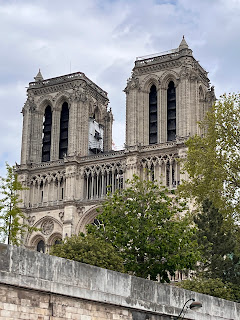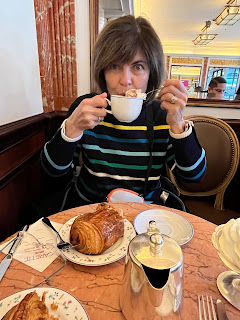France hadn’t been on my bucket list. First off, there’s the
whole foreign language thing. Not my forte, in the same range that brain
surgery isn’t my forte. Then there's the reputation of French inhospitableness,
particularly toward Americans. If I’m not wanted, don’t worry, I’ll stay away. Finally,
I imagined it as a snooty, glitzy, high-end-fashion kind of place – you know,
movie stars, swimming pools – out of my comfort zone.
 We ended up going to fulfill a dream of Donna’s: Not so much
of seeing Paris (she had done so years ago on a high-school trip), but of
seeing Yundi Li, a 40-year-old Chinese pianist, give a performance there.
We ended up going to fulfill a dream of Donna’s: Not so much
of seeing Paris (she had done so years ago on a high-school trip), but of
seeing Yundi Li, a 40-year-old Chinese pianist, give a performance there.The language barrier turned out to be manageable. Donna took eight years of French in school and was using Pimsleur to bone up. I started using the online app too – though at the introductory level. In real life, I could have gotten by without Donna’s near fluency because most of the servers, shopkeepers, and workers we encountered spoke more English well, or certainly better than I spoke French. For the few who didn’t, gesticulating and shouting usually worked (I kid). Bilingual menus and phone translation apps take care of any other language issues.
The attitude thing didn’t confront us at all. Donna’s
French-first approach certainly helped, I’m sure. But the local people we met
were friendly, welcoming, and warm.

We took
a boat tour to get our bearings, walked many miles, learned a bit about the
history and culture, ate extremely well at incredible restaurants, and, the
best part for me, spent many hours sitting at cafes and bistros, where we enjoyed
the food and the wine and soaked in the whole experience. We had the perfect
week.
Here are fun facts, followed by more photos....
Fun facts
St. Denis took a licking and kept on ticking. The Catholic bishop in Paris during the third century A.D. was beheaded under orders of the Roman Emperor Decius for defying his edict to make sacrifices to Roman gods. According to myth, St. Denis walked for several miles to what is now Montmartre (which means mountain of the martyr) carrying his severed head, continuing to proclaim the Catholic faith. He is now the patron saint of Paris and France.
Speaking of Montmartre, it was home to aspiring (meaning poor) artists before they hit the big time. We saw the very modest homes of Picasso, Van Gogh, Renoir, and other greats.
All those beautiful buildings in Paris are made from plaster of Paris (really!). Gypsum was mined at Montmartre and turned into the material used for the exteriors of buildings. It’s why they all are of the same, cream color. Side note: The Sacre Coeur cathedral atop Montmartre took forever to build, partly because the foundation had to be extremely deep on account of the extensive mine tunnels, which rendered the land on the hilltop unstable.

Over-pimping your crib can be hazardous to your health – The over-the-top splendor, magnitude, and ostentatiousness of Versailles makes it easy to see why the impoverished and disenfranchised masses took to the streets and revolted in the late 1700s. Louis XVI and Marie Antoinette were decapitated, but there’s no record of either of them doing a headless walkabout.
By the way, our visit to Versailles wasn’t a great experience. It’s like Disneyworld on steroids: We waited in line over an hour despite having timed-entry passes, and were herded like cattle from one ornate room to another in the main mansion. We bailed before getting to the upstairs Hall of Mirrors, waited in line for 20 minutes for the restrooms, then spent the rest of our time in the magnificent gardens.
The Latin Quarter is awesome. Like Montmartre, it retained the winding streets and alleys that make it so charming. It has been a magnet for writers the way Montmartre drew (and continues to draw) artists. There are ancient churches, such as La Severin, quaint, charming (that word again) cafes and bistros, and the Hogwarts-like Shakespeare Bookstore. It’s also adjacent to the Ile de Cite, where sits the scaffolding-sheathed yet majestic Notre Dame Cathedral.


Young, Asian women who idolize Li like a rock star follow him all over the world to his performances. They wore traditional embroidered garb, long gowns, or tiny, skin-tight outfits, and most brought large bouquets of roses to present to the pianist. One, sitting next to us, said she had seen him in Vienna before the Paris concert but was unsure if she would be able to attend upcoming concerts in Germany.
Sundays are not the day to go to the museums. We thought we'd visit a museum but didn't want to lock ourselves into it so we didn't buy tickets in advance. So after a splendid brunch (tip: don't try welkes; they are disgusting), we walked to the Musee D'Orsay but couldn't get in. Then we walked through the Jardin les Tuileries to the Louvre but couldn't get in. Finally we went to the Orangerie Museum and surprisingly couldn't get in. Definitely a case of it's the journey, not the destination -- the breathtaking architecture, the beautiful gardens, and just Paris, was well worth our trek. We went back to the bistro across from our hotel to drink wine and watch the world go by, a la Anthony Bourdain.
Louvre
Versailles Musical Gardens
Montmartre























%20-%20Copy.JPG)

















Comments
Post a Comment